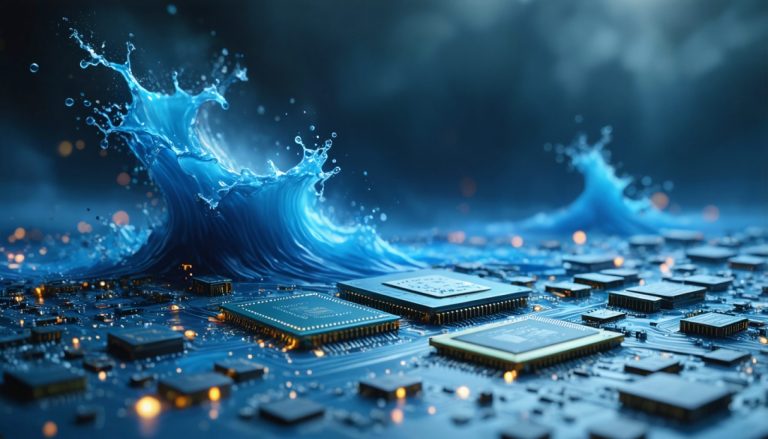
- CoreWeave’s stock opened at $39, well below its initial pricing expectations of $47-$55, signaling investor caution in the AI sector.
- Despite Nvidia’s $250 million investment, declining demand for GPUs and significant debt pose challenges for CoreWeave.
- Founded during the crypto craze, CoreWeave shifted focus to AI, supplying essential GPUs—tools crucial for AI innovation.
- Microsoft, a major partner responsible for 60% of CoreWeave’s 2024 revenue, is reducing its AI infrastructure investments, impacting CoreWeave’s stability.
- Market softness is evident as GPU rental prices drop from $5.50 to $1.55 per hour, reflecting diminished demand.
- CoreWeave’s financial strains are exacerbated by $6 billion in expenses against $1.9 billion revenue and risky financial strategies.
- The IPO serves as a barometer for the AI and GPU markets, highlighting potential pitfalls amid optimism for AI’s future.
A curious scene unfolded as CoreWeave made its debut on the stock market today, setting a hesitant tone for the AI industry. Enthusiasts once buzzed with excitement about its potential, but CoreWeave stumbled out of the gate, opening at $39 per share—a stark contrast to its initial hopeful pricing of $47-$55. Despite robust support from Nvidia, which injected $250 million into the company in a show of force, the cold shoulder from investors sent ripples through the AI sector.
A look beneath the surface reveals an intricate tale of ambition colliding with hard economic truths. Founded in 2017 amid the cryptocurrency rush, CoreWeave supplied graphics processing units (GPUs) to miners hungry for computing power. As the crypto craze waned, the company deftly pivoted to ride the AI wave, positioning itself as a critical supplier of the “picks and shovels” that drive today’s AI innovations.
Yet, the tide may be shifting. The once-insatiable demand for GPUs appears to be cooling. Microsoft, a cornerstone customer, recently dialed back its investment in AI infrastructure, withdrawing significant leasing agreements globally. This pullback has left CoreWeave in a precarious position—60% of its revenue in 2024 came courtesy of Microsoft, a partner now hedging its bets.
The technological landscape is shifting rapidly. As OpenAI’s groundbreaking ChatGPT once spurred unprecedented GPU demand, recent adjustments have dampened the fervor. Renting a GPU, which commanded prices of $5.50 per hour in mid-2023, now costs a mere $1.55, underscoring a softened market that could spell trouble for CoreWeave.
Adding to this complexity is a staggering debt burden that looms ominously over the company. Despite healthy revenues of $1.9 billion in 2024, CoreWeave’s prodigious expenses surpassed $6 billion last year alone. The decision to use GPUs as collateral highlights a risky endeavor, especially as GPU prices dip and leaner AI models emerge.
This IPO could serve as a bellwether for the AI and GPU markets—both fraught with potential and peril. Industry leaders like Nvidia’s Jensen Huang speak optimistically of AI’s future demands, yet practical arguments can’t mask the reality: CoreWeave is navigating treacherous waters, reliant on a handful of backers and caught in a speculative whirlwind.
CoreWeave’s journey demonstrates the volatility in today’s tech landscape, where aspirations often clash with economic imperatives. As investors appraise this new frontier, the cautionary tale of CoreWeave may shape their decisions on whether this AI gold rush holds lasting promise or fleeting allure. As the company steers a ship through turbulent seas, one can’t help but wonder: Is this the dawn of a new era in AI, or a momentary mirage?
CoreWeave’s Rocky IPO: What It Means for the AI and GPU Markets
Unpacking the CoreWeave IPO: Challenges and Opportunities for the AI Industry
CoreWeave’s recent IPO has been a subject of much discussion due to its unexpected debut performance. Despite having strong backing from industry giant Nvidia, CoreWeave opened at a disappointing $39 per share, significantly below its anticipated range of $47-$55. This development has sparked concerns about the health and trajectory of both the AI and GPU markets.
Key Insights and Market Trends
1. Market Volatility and AI Demand Shifts:
– CoreWeave’s debut reflects broader market uncertainties. With companies like Microsoft reducing investment in AI infrastructure, the overall demand for GPUs seems to be stabilizing after a period of aggressive growth. This trend is highlighted by the considerable drop in GPU leasing prices from $5.50 to $1.55 per hour.
2. Debt and Financial Strain:
– Despite generating $1.9 billion in revenue in 2024, CoreWeave is burdened by overwhelming expenses exceeding $6 billion. Utilizing GPUs as collateral in light of declining GPU prices is a precarious strategy, indicating potential financial vulnerability.
3. Impact on AI Infrastructure Providers:
– CoreWeave’s IPO outcome may signal a shift in investor expectations and confidence in AI infrastructure specialists. The cooling enthusiasm could encourage a reevaluation of strategies among AI service providers and related companies.
Pressing Questions and Expert Opinions
– What does CoreWeave’s performance mean for investors?
Investors might become more cautious about backing AI infrastructure companies with heavy reliance on a few key clients. Diversification of clientele and services could become a significant focus for future growth and stability.
– Is the AI market facing a correction?
While AI remains a crucial element of technological growth, the sector may be experiencing a natural adjustment period. Companies need to adapt to the new levels of demand and shift focus towards developing leaner AI models that require less computational power, reducing reliance on expensive GPU-driven solutions.
Future Projections
Although the current trajectory seems uncertain, the AI sector’s long-term potential remains robust. Emphasis on AI-driven solutions continues to rise across various industries, from healthcare to finance. Maintaining technological innovation and operational efficiency will be key for companies like CoreWeave to weather this tumultuous phase successfully.
Recommendations for Industry Players
– Diversify Client Base: Companies should focus on expanding their client base beyond a few large partners to mitigate risks associated with demand fluctuations.
– Invest in Efficient Technologies: Embracing leaner, more efficient AI models could preserve profitability even as GPU costs evolve.
– Enhance Financial Management: Streamlining expenses and improving debt management strategies can help safeguard financial health against market downturns.
For more insights into AI and technological developments, visit Nvidia and explore their latest innovations and expert analyses.
Quick Tips for AI Enthusiasts
– Stay informed about market trends and technological advancements.
– Follow influential industry leaders’ analyses to better understand prospects.
– Consider the role of emerging AI models in enhancing efficiencies and reducing costs.
In conclusion, while CoreWeave’s IPO might indicate short-term challenges, it also presents opportunities for strategic adaptation within the dynamic AI landscape, encouraging innovation and evolution in how AI solutions are developed and deployed.



